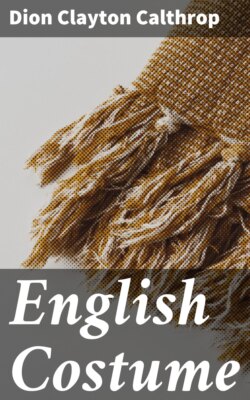Читать книгу English Costume - Dion Clayton Calthrop - Страница 18
На сайте Литреса книга снята с продажи.
THE WOMEN
ОглавлениеTable of Contents
Though many parts of England were at this time being harassed by wars, still the domestic element grew and flourished.
The homes of the English from being bare and rude began to know the delights of embroidery and weaving. The workroom of the ladies was the most civilized part of the castle, and the effect of the Norman invasion of foreign fashions was beginning to be felt.
As the knights were away to their fighting, so were the knights’ ladies engaged in sewing sleeve embroideries, placing of pearls upon shoes, making silk cases for their hair, and otherwise stitching, cutting, and contriving against the return of their lords.
It is recorded that Matilda escaped from Oxford by a postern in a white dress, and no doubt her women sympathizers made much of white for dresses.
The ladies wore a simple undergarment of thin material called a sherte or camise; this was bordered with some slight embroidery, and had tightish long sleeves pushed back over the wrist. The garment fell well on to the ground. This camise was worn by all classes.
The upper garment was one of three kinds: made from the neck to below the breast, including the sleeves of soft material; from the breast to the hips it was made of some elastic material, as knitted wool or thin cloth, stiffened by criss-cross bands of cloth, and was fitted to the figure and laced up the back; the lower part was made of the same material as the sleeves and bust.
A WOMAN OF THE TIME OF STEPHEN (1135-1154)
Her dress fits to her figure by lacing at the back. Her long sleeves are tied up to keep them from trailing upon the ground. Her hair is fastened at the end into silken cases. She has a wimple in her hands which she may wind about her head.
The second was made tight-fitting in the body and bust, all of one elastic material, and the skirt of loose thin stuff.
The third was a loose tunic reaching half-way between the knees and feet, showing the camise, and tied about the waist and hips by a long girdle.
The sleeves of these garments showed as many variations as those of the men, but with the poor folk they were short and useful, and with the rich they went to extreme length, and were often knotted to prevent them from trailing on the ground.
The collar and the borders of the sleeves were enriched with embroidery in simple designs.
In the case of the loose upper garment the border was also embroidered.
In winter a cloak of the same shape as was worn by the men was used—i.e., cut exactly semicircular, with embroidered edges.
The shoes of the ladies were fitted to the foot in no extravagant shape, and were sewn with bands of pearls or embroidery. The poorer folk went about barefoot.
The hair was a matter of great moment and most carefully treated; it was parted in the centre and then plaited, sometimes intertwined with coloured ribbands or twists of thin coloured material; it was added to in length by artificial hair, and was tied up in a number of ways. Either it was placed in a tight silk case, like an umbrella case, which came about half-way up the plait from the bottom, and had little tassels depending from it, or the hair was added to till it reached nearly to the feet, and was bound round with ribbands, the ends having little gold or silver pendants. The hair hung, as a rule, down the front on either side of the face, or occasionally behind down the back, as was the case when the wimple was worn.
When the ladies went travelling or out riding they rode astride like men, and wore the ordinary common-hooded cloak.
Brooches for the tunic and rings for the fingers were common among the wealthy.
The plait was introduced into the architecture of the time, as is shown by a Norman moulding at Durham.
Compared with the Saxon ladies, these ladies of Stephen’s time were elegantly attired; compared with the Plantagenet ladies, they were dressed in the simplest of costumes. No doubt there were, as in all ages, women who gave all their body and soul to clothes, who wore sleeves twice the length of anyone else, who had more elaborate plaits and more highly ornamented shoes; but, taking the period as a whole, the clothes of both sexes were plainer than in any other period of English history.
One must remember that when the Normans came into the country the gentlemen among the Saxons had already borrowed the fashions prevalent in France, but that the ladies still kept in the main to simple clothes; indeed, it was the man who strutted to woo clad in all the fopperies of his time—to win the simple woman who toiled and span to deck her lord in extravagant embroideries.
